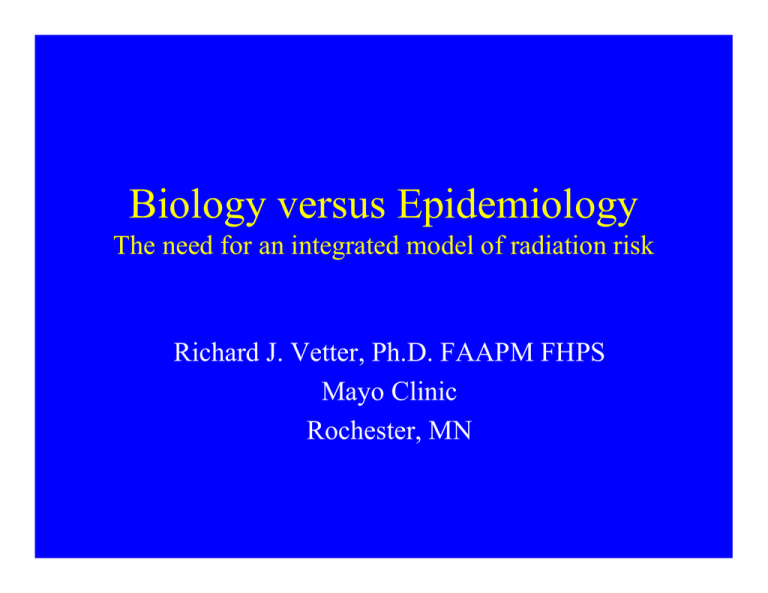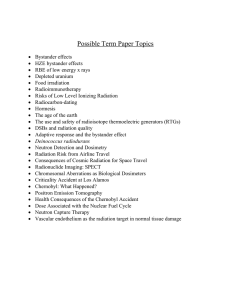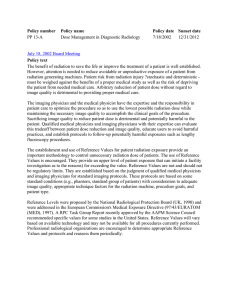Biology versus Epidemiology Richard J. Vetter, Ph.D. FAAPM FHPS Mayo Clinic
advertisement

Biology versus Epidemiology The need for an integrated model of radiation risk Richard J. Vetter, Ph.D. FAAPM FHPS Mayo Clinic Rochester, MN Acknowledgements William Morgan, Ph.D. Director Radiation Biology & Biophysics Pacific Northwest National Laboratory Richland, Washington Perceptions of Risk vs. Benefit Perceptions of Risk Cancer Mortality ERR in LSS 1950-1997a Dose (Sv) ERR/Svb P Valuec 0-0.05 0.9 0.15 0-0.1 0.64 0.30 0-0.125 0.74 0.025 0-0.15 0.56 0.045 0-0.2 0.76 0.003 0-0.5 0.44 <0.001 0-1 0.47 <0.001 0-2 0.54 <0.001 0-4 0.47 <0.001 aPreston bBEIR et al.Rad Res 160: 381-407; 2003. VII ERR/Sv = 0.5 cOne-side test that slope = 0 Health Physics Society Position • Recommends against quantitative estimation of health risks below an individual dose of 5 rem in one year or a lifetime dose of 10 rem above that received from natural sources. • For doses below 5–10 rem risks of health effects are either too small to be observed or are nonexistent. Average Doses Radiation Doses from Various Imaging Procedures Procedure Adult E (mSv) Dental 0.005-0.01 Chest 0.02 CT 2-16 Fluoroscopy 5-70 Mettler, et al. 2008 Annual Dose Limits (mSv) Effective Dose 50 Lens 150* Skin 500 Single Organ 500 EPA PAG 20 ICRP 103 recommends 20 LNT • Even the smallest quantity of radiation exposure carries some finite cancer risk. • Thus, eliminate radiation exposure, reduce it ALARA, or optimize it. Risk from Medical CT Risk from Medical CT Radiation Risks in Medicine • Radiation risk from nth scan = 5 X 10-2 Sv-1 – For patient with history of 1 scan, additional risk = 5 X 10-2 Sv-1 – For patient with history of 10 scans, additional risk = 5 X 10-2 Sv-1 – For patient with history of 100 scans, additional risk = 5 X 10-2 Sv-1 Radiation Risks in Medicine • LNT: medical imaging may cause up to 2% of future cancers in the United States1 • Cumulative dose estimates for patients are of little clinical relevance and never constitute a logical reason to avoid an imaging evaluation that is otherwise medically indicated2. -----------------• • 1Brenner & Hall; N Engl J Med 2007; 357:2277–2284 2Durand; AJR 2011; 197:160–162 Excess Relative Risk per Sv in Workers (all cancer excluding leukemia in cohorts with more than 100 deaths; 407,391 workers in 15 countries; NPP=nuclear power plants) Ninety per cent of workers received cumulative doses < 50 mSv and less than 0.1% received cumulative doses > 500 mSv. Cardis et al. BMJ. 2005 July 9; 331(7508): 77. Comments on Cardis • Shigematsu. (2005 BMJ 331 August 9): ERR due to radiation loses statistical significance when the Canadian data are excluded. • Lagarde. (2005 BMJ 331 August 9): ERR estimates reported may actually be underestimating the real risks. • Debrouwer. (2005 BMJ 331 Sept 9): non-systematic bias, but maybe not, can make the results of the studies dubious. • McGeoghegan. (2005 BMJ 331 Oct 3): elimination of Canada and smokers eliminates significance. On the Other Hand - Biology • Complex biological systems have physiological barriers and repair mechanisms against damage and disease. • Primary damage linear with dose, secondary damage often non-linear. • Cellular processes block damage. • Propagation to clinical disease is complex. In the Context Of Radiation Protection • How to extrapolate biological effects at low doses to risk? • Are extrapolations from “high dose” acute exposures appropriate when human exposure is primarily chronic low dose exposure? The Current Paradigm of Radiation Risk Radiation DNA Repair DNA Damage Mutation Somatic Germline Carncinogenesis Genetic Heritable Apoptosis Fetal Developmental Hot Topics in Radiobiology • • • • • • Low dose radiation hypersensitivity Adaptive responses Epigenetic modifications Non-targeted genomic instability Non-targeted bystander effects Non-cancer effects Adaptive Response • When large radiation exposure is preceded by a small “tickle” dose, the effect of the large dose is sometimes diminished. • Small doses of radiation appear to stimulate protective responses, triggering DNA repair mechanisms and the elimination of severely damaged cells (apoptosis). Adaptive Response • Your first summer day at the beach, you don’t spend 8 hours in the sun. • You begin with an hour or two and add additional time as your skin adapts to the sunny condition and develops protective mechanisms Radiation Induced Neoplastic Transformation In Vitro Redpath et al. 2001 Bystander Effects (Field Effect in Cancer)* • Signals sent by bystander cells may help repair the damaged cell, or they may trigger apoptosis in damaged cell. OR • Signals in damaged cell may disrupt normal function of bystander cells. *Slaughter et al., Cancer 1953;6:963–968. Observed Bystander Effects • • • • • • • Changes in gene expression. Mutations. Apoptosis. Chromosome aberrations. Cell transformation. Cancer. Changes in sister chromatid exchanges. Genomic Instability (Delayed Genetic Effects) • Detrimental effects that occur several cell generations after radiation exposure. • Often, cells repair DNA damage and reproduce normally. • In some cases genetic damage is observed several generations after damage occurred. Genomic Instability • Provides a mechanism to explain how radiation can produce the multiple steps needed to transform a normal cell into a malignant cell. • Supports LNT if cellular genomic instability can be shown to increase cancer frequency. DNA Damage & Repair • DNA damage caused by radiation exhibits multiply damaged sites. • Single strand breaks are more common in normal endogenous DNA damage. • Double strand breaks are more common in radiation induced damage. DNA Damage & Repair • Single strand break repair is usually error free. • Double strand breaks can be either error free or error prone, containing a high error rate. • Data suggest non-linear process. Extrapolation from Experimental Systems • What does in vitro cell culture tell us about what happens in the human? • What do in vivo models tell us about what happens in the human? • How to extrapolate from in vivo models to humans? Radiation Response Model • Public & Worker Protection based on LNT • Realities: Tissue sensitivity varies with: – Age – Sex – Socio-economic status – Diet & lifestyle – Genetic makeup & race – Dose & dose rate – Radiation quality Questions • How to design a system that limits risk? – Most sensitive organ? – Most sensitive individual? • How do we assign individual human risk? • What science do we need to accomplish this? • Where do we set the “threshold” – for regulatory purposes? – for clinical purposes? Conclusions • Epidemiology isn’t sensitive enough to provide definitive information at low doses. • Radiobiology research will continue to elucidate mechanisms, but not population risk. • Use of LNT works for prospective protection of public health but doesn’t provide accurate results for risk. Conclusions • LNT: biology suggests that not all systems respond to radiation linearly. • Regulatory use of LNT is “safe bet.” • Use of LNT to calculate risk from medical radiation is “risky.”




